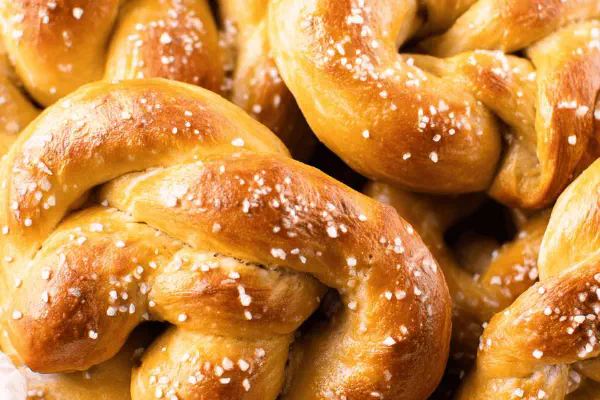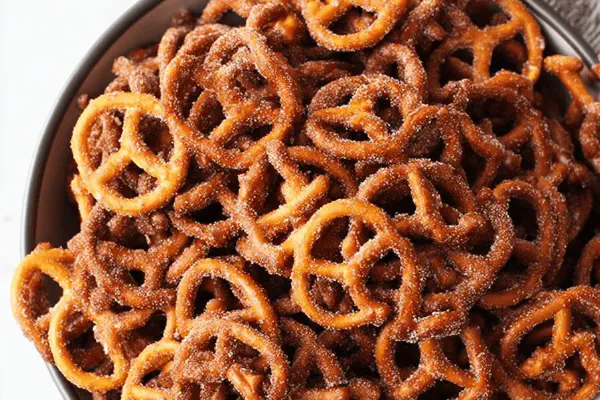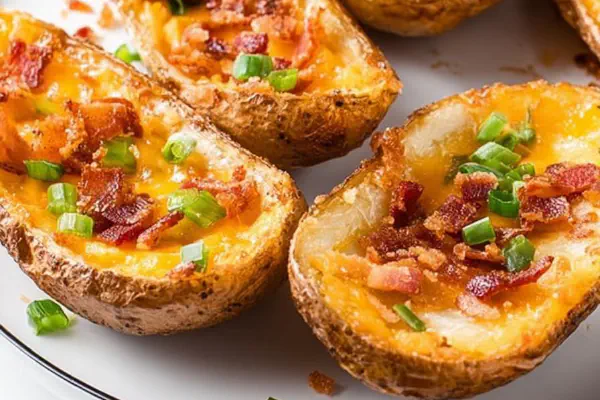Homemade Soft Pretzels

By Emma
Certified Culinary Professional
Ingredients
- 1 1/2 cups warm water around 95 to 105°F
- 2 tablespoons honey swapped with maple syrup works too
- 1 1/2 teaspoons fine salt with a pinch extra for topping
- 4 cups bread flour can go all-purpose but less chew
- 1 packet instant yeast about 2 1/4 teaspoons
- 4 tablespoons unsalted butter melted, slightly cooled
- 1/3 cup baking soda for bath (adjusted from 1/4 cup)
- Melted butter for brushing on top about 1/4 cup
About the ingredients
Method
- Start by mixing the warm water with honey and salt in your stand mixer bowl. Stir a bit until the honey and salt vanish, no granules left. Slightly warmer water too hot kills yeast. I always check with my wrist.
- Add flour and yeast all at once. Using the dough hook, turn mixer on low speed, setting 1 on mine. Slowly drizzle your butter in while mixing so it gets well incorporated without clumping.
- Mix for 2 minutes on low to fully meld ingredients, then bump speed to medium-low, setting 3 for 6 minutes instead of 5. Feel the dough gripping the hook, smooth but still a little sticky to touch, not dry or overly tacky. If too sticky add a tablespoon more flour, but careful, too much flattens the chew.
- Remove the dough hook and cover the bowl loosely with plastic wrap. Rest it in a draft-free spot to rise. The dough should at least double in size, roughly 55 minutes—watch the puff, don't just trust the clock. Bigger bubbles mean better airiness.
- Heat oven to 400 degrees Fahrenheit. Prepare your baking sheet with parchment or a silicone baking mat. This avoids sticking and allows crisp bottoms.
- Flour your work surface with remaining 1/4 cup flour. Dump out the dough, gently press it into an 8 by 20-inch rectangle. Be gentle here or risk tightening gluten too much. No need to punch down hard, just coax it flat.
- Use a sharp knife or pizza cutter to slice into eight strips, each about 1 by 20 inches. Roll each strip into a rope carefully, don't overwork — dough relaxes easier than it resists.
- To twist pretzels, cross ends forming a circle with overhang about 2 inches, loop over again crossing over. Hold twisted ends, bring to bottom of loop. Classic shape or go freestyle experimentation could end ugly but fun. Place pretzels on baking sheet to rest and puff a bit while prepping bath.
- In a deep baking dish with 2-inch sides, dissolve 1/3 cup baking soda in very hot water. Stir well until soda fully dissolves. This alkaline bath builds that shiny, chewy iconic crust.
- Lower pretzels carefully into soda water, 1 or 2 at a time depending on size, soak for about 30 seconds each side. Flip gently, not to deflate bubbles in dough. Use slotted spoon or spider to remove, let excess drip off before returning them to sheet.
- Bake in hot oven for about 15 minutes. Keep watch—golden brown edges, not too dark. The smell should be warm, buttery, with that baked bread aroma wafting nicely.
- While baking, microwave 1/4 cup butter until melted, about 25 to 30 seconds. Use this for brushing the moment pretzels come out, locking in softness and adding shine.
- Brush generously and scatter coarse salt on top while butter is still warm. That contrast of salty crunch and soft chew is addictive.
- Let cool slightly before digging in, but warm is the magic moment.
- Substitution tips and problem-solving: Maple syrup works for honey dryer dough needs less flour. All-purpose flour makes softer but less chewy pretzels. Watch water temp: too hot kills yeast, too cold slows rising. Overbaking makes them tough; underbaking leaves dough gummy. Use silicone mats for easier cleanup.
- Trying lard or vegetable oil for butter yielded less flavor and poor dough cohesion in past attempts. Sticking to butter.
- Baking soda bath is non-negotiable for pretzel texture; tried baking powder - flat, dull crust.
- If dough sticks too much during shaping, flour hands lightly but avoid excess or dough will dry out.
Cooking tips
Chef's notes
- 💡 Water temp matters—too hot kills yeast, too cold slows rise. Check wrist heat zone around 95-105°F. Honey or maple syrup sweetens gently; maple dries dough a bit, adjust flour. Butter melts in slowly during mixing, prevents clumps, coats flour for crumb. Knead till dough grips hook but remains slightly sticky, add flour tablespoon by tablespoon if too wet but cautious—too much ruins chew.
- 💡 Rest dough loosely covered. Watch size not time. Bubbles form, dough feels springy. Over-handle slows fluff. Shape delicately; rolling ropes about 1 by 20 inches keeps tension just right. No punching down hard, just coax flat for shaping. Twist pretzels gently, break bubbles and chew suffer. Slip dough in baking soda bath carefully, 30 seconds per side max, flip slow to keep airy crumb intact.
- 💡 Bath uses hot water, fully dissolve baking soda, no grit. That makes crust shiny, chewy, signature bite. Use slotted spoon or spider to fish pretzels out, drip excess thoroughly before baking. Oven at 400°F, golden edges show doneness, smell butter and warm bread aroma. Microwave butter post-bake, brush immediately, seals inside softness; salt scatter adds crunch contrast to finish.
- 💡 Flour surface lightly before shaping but avoid excess or outer crust toughens. If dough sticks on hands, dust lightly but excess dries dough hard. Tried lard or veg oil swaps for butter yielded flat flavor, poor dough cohesion—stick with butter when possible. Baking powder in bath fails—flat, dull crust only. Water bath non-negotiable step, no shortcuts here for texture.
- 💡 Prep surface 8x20-inch rectangle gently, too much pressure tightens gluten and kills chew. Roll ropes slow, don’t rush or dough snaps back. Use parchment or silicone mats to avoid sticking and allow crisp bottoms. Timing in oven varies, sensory clues trump clock. Golden with strong aroma tells you when to pull. Too dark means tough; underbaked feels gummy. Cooling slightly helps retain softness but warm is prime moment.
Common questions
Can I use all-purpose flour instead of bread flour?
Yes, softer texture, less chew. Dough sticks more, handle gently. Might need slight less water. Not big leap, just expect softer, fluffier but less structure. Adjust flour cautiously.
How long should the dough rise?
Look for doubled size, bubbles, light spring back. Clock is rough guide, 55 minutes typical. Cooler kitchens need more time; warm ones less. Watch, press lightly. Puffy balloon, not flat or dense.
What to do if dough is too sticky?
Add flour in tablespoons, slowly. Sticky dough means too wet, but too much flour dries and flattens crumb. Balance by feel. Dust your surface lightly when shaping to avoid sticking.
Can I store pretzels?
Room temp okay 1 day, wrapped loose to avoid drying. Fridge tightens dough fast, reheat oven 5-7 mins brings softness back. Freeze before baking or after cool; thaw slow then warm oven. Don’t stack fresh warm or get soggy spots.



